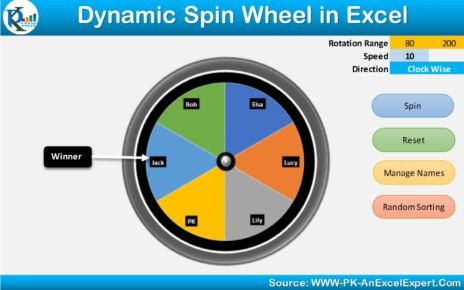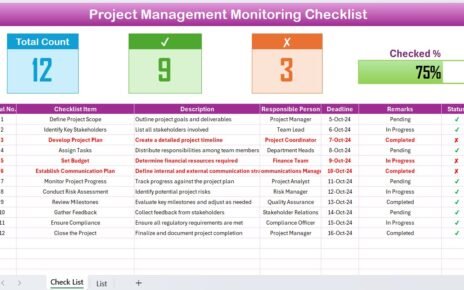In the world of project management, staying organized and on top of tasks is essential for success. A well-structured Project Management Schedule Checklist helps project managers, teams, and stakeholders stay aligned, ensuring that all tasks are completed on time and according to plan. Excel, being a widely-used tool, can significantly streamline this process. In this article, we’ll delve into the Project Management Schedule Checklist in Excel, explaining its key features, advantages, best practices, and how you can leverage this checklist to improve your project management workflow.
What is a Project Management Schedule Checklist in Excel?
A Project Management Schedule Checklist in Excel is a tool that helps project managers and teams track the progress of tasks within a project. It provides a detailed breakdown of each task, its status, deadlines, responsible persons, and any additional remarks or notes. Excel makes it easy to capture and analyze this data in a structured way, offering a clear overview of the entire project.
By using an Excel-based checklist, teams can update the status of each task, view who is responsible for each, and track the project’s overall progress. This approach helps ensure that the project is moving forward according to the plan, and it allows for quick identification of any delays or issues.
Key Features of the Project Management Schedule Checklist in Excel
The Project Management Schedule Checklist Template is a ready-to-use tool designed to simplify project tracking. It includes two primary worksheets:
1. Project Management Schedule Checklist Sheet Tab
Top Section:
The Top Section provides essential project information, including:
- Total Count: Displays the total number of checklist items.
- Checked Count: Shows the number of tasks completed or marked as ✔.
- Crossed Count: Displays the number of tasks that were skipped or marked with ✘.
- Progress Bar: A visual progress bar indicates the percentage of tasks completed based on the checked count.

Click to Project Management Schedule
Checklist Table:
The main part of the sheet consists of a checklist table where each task is recorded and its status is updated. The columns in this table include:
- Serial No.: A unique identifier for each checklist item.
- Checklist Item: The name of the task or deliverable.
- Description: A brief explanation of the task.
- Responsible Person: The individual or team responsible for completing the task.
- Deadline: The due date for the task’s completion.
- Remarks: Any additional notes or comments regarding the task.
- Status: A checkbox where the task can be marked as completed (✔) or not completed (✘).
2. List Sheet Tab
- Main Purpose: This sheet contains a list of all Responsible Persons. It is used to create a drop-down list in the main checklist table, making it easy to assign tasks to team members.
- Functionality: When a user adds or updates the names of team members in this sheet, it automatically updates the dropdown menu in the Responsible Person column of the checklist table. This ensures consistency and accuracy in task assignment.

Click to Project Management Schedule
Advantages of Using the Project Management Schedule Checklist in Excel
- Centralized Task Management: Having all tasks in a single document provides a centralized view of the entire project. It enables easy tracking of progress, deadlines, and responsibilities, reducing the risk of missing tasks.
- Real-Time Updates: The Excel checklist can be updated in real-time, making it easy for project managers and teams to keep track of changes. Whether a task is completed or delayed, everyone can stay informed.
- Improved Collaboration: By using a shared Excel file, team members can collaborate more effectively. The checklist allows multiple users to update the status, add remarks, and adjust deadlines, all in one place.
- Visual Progress Tracking: The progress bar feature gives project managers an instant overview of how much work has been completed. It also helps highlight delays and bottlenecks, enabling timely interventions.
- Customizable: The Project Management Schedule Checklist template is highly customizable. You can modify the columns, add new sections, or update the drop-down list to suit the specific needs of your project.
Opportunities for Improvement in the Project Management Schedule Checklist
While the Project Management Schedule Checklist in Excel offers great advantages, there are always opportunities for improvement. Here are some suggestions:
- Automating Updates: Automating the updating process through integration with project management tools or time-tracking software can reduce manual work and errors. For example, you can set up automated notifications for upcoming deadlines or overdue tasks.
- Advanced Reporting Features: Adding more advanced reporting capabilities, such as charts or pivot tables, could provide deeper insights into the project’s performance. This would make it easier to identify trends, track progress, and highlight areas that need attention.
- Cloud Integration: Storing the checklist in the cloud (e.g., Google Sheets or Microsoft OneDrive) would enable easier sharing and collaboration. It would also allow real-time updates and access to the checklist from anywhere.
- Linking Dependencies Between Tasks: For projects with interdependent tasks, adding a feature to link tasks together and automatically update deadlines based on changes would be extremely useful.
Best Practices for Using the Project Management Schedule Checklist
- Regularly Update the Checklist: Ensure that the checklist is updated regularly to reflect the latest project status. This includes updating the status of tasks, revising deadlines, and adding new tasks as needed.
- Focus on Key Tasks: While it’s essential to track all tasks, prioritize the most critical ones. Mark high-priority tasks with distinct colors or symbols to easily differentiate them.
- Set Realistic Deadlines: Make sure the deadlines you set are achievable. Unrealistic deadlines can create unnecessary pressure and result in delays. Use the checklist to regularly review timelines and make adjustments as needed.
- Incorporate Feedback: Regularly ask team members for feedback on the checklist and make improvements. This helps ensure that it meets the team’s needs and stays aligned with the project’s goals.
- Use Conditional Formatting: Apply conditional formatting to the checklist, such as color-coding tasks based on their status. This makes it easier to spot completed, delayed, or pending tasks at a glance.
Frequently Asked Questions (FAQs)
What is the Project Management Schedule Checklist in Excel?
The Project Management Schedule Checklist in Excel is a tool that helps project managers and teams track the tasks and milestones of a project. It includes sections for task names, deadlines, responsible individuals, and status updates.
How can I assign tasks using this checklist?
You can assign tasks by selecting the responsible person’s name from a drop-down list in the Responsible Person column. This list is updated from the List Sheet Tab, where you can input the names of your team members.
Can I track the progress of tasks in real time?
Yes, the progress bar at the top of the checklist sheet updates automatically to reflect the percentage of completed tasks based on the current status of items marked as ✔ or ✘.
Can I customize the checklist for my specific project needs?
Absolutely! The checklist is highly customizable. You can modify columns, update tasks, adjust deadlines, and create new sections to fit the specific needs of your project.
Is this template suitable for large teams?
Yes, the Project Management Schedule Checklist is suitable for both small and large teams. With shared access, everyone can update their tasks, ensuring that the project stays on track.
Conclusion
The Project Management Schedule Checklist in Excel is an invaluable tool for any project manager looking to streamline their task management process. By tracking key tasks, assigning responsibilities, and setting clear deadlines, this checklist ensures that every aspect of your project is accounted for. Whether you’re managing a small team or coordinating a large-scale project, this Excel template helps improve efficiency, foster collaboration, and ensure project success.
Visit our YouTube channel to learn step-by-step video tutorials
View this post on Instagram



